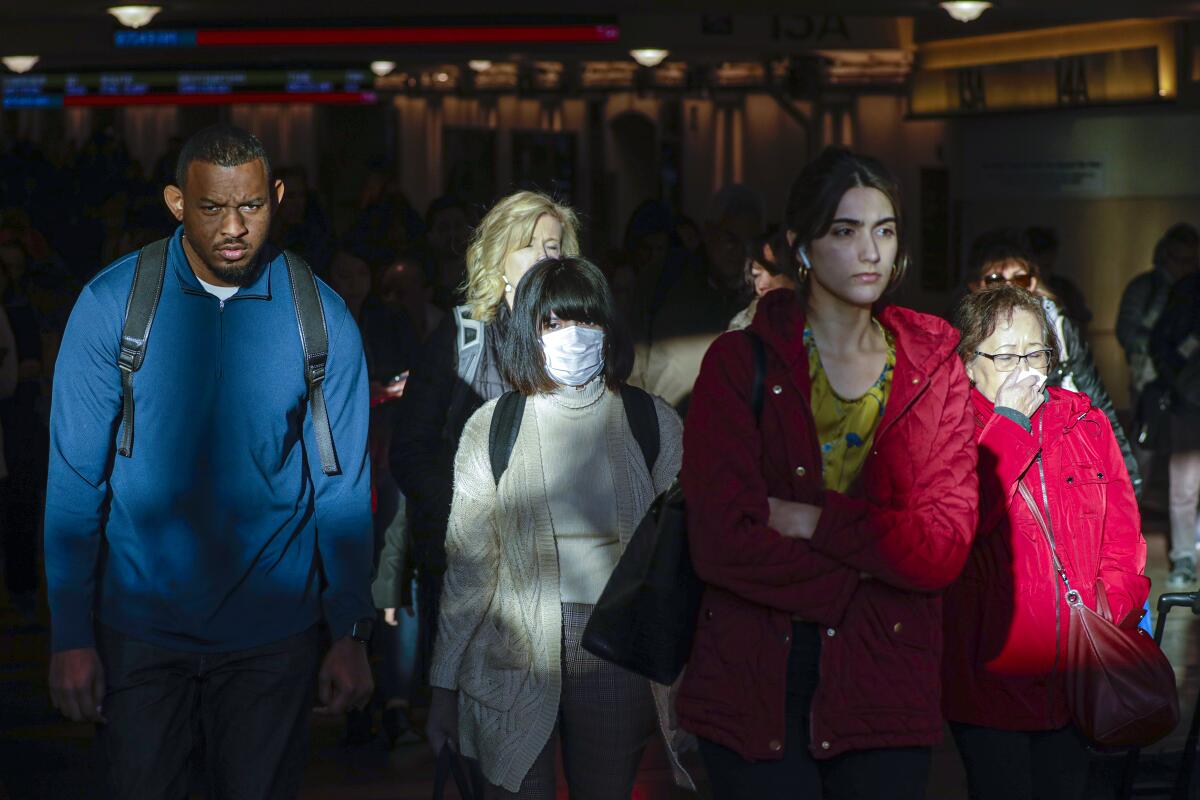Newsletter: What ‘community spread’ means for the coronavirus

- Share via
Good morning, and welcome to the Essential California newsletter. It’s Thursday, Feb. 27, and I’m writing from Los Angeles.
Sign up for Essential California
The most important California stories and recommendations in your inbox every morning.
You may occasionally receive promotional content from the Los Angeles Times.
On Tuesday, the Centers for Disease Control and Prevention warned that the spread of the coronavirus within U.S. communities was probably inevitable, with the CDC’s director saying that it was “not so much a question of if, but a question of when.”
That “when” may have arrived just a day later. On Wednesday, the CDC confirmed it is investigating what could be the first instance of “community spread” of the virus in the U.S., after a California resident being treated at UC Davis Medical Center tested positive.
[Read the story: “California coronavirus case could be first spread within U.S. community, CDC says” in the Los Angeles Times]
What does “community spread” mean?
Community spread, according to the CDC, refers to the “spread of an illness for which the source of infection is unknown.”
All of the other known coronavirus cases in the U.S. have involved individuals who either recently traveled out of the country or had known contact with someone who did. But in this new California case, the patient had not recently traveled out of the country, nor could public health workers identify any prior contact between the patient and people who had traveled to China or other areas where the virus is widespread. It’s not clear how the person became infected, and the CDC said that it’s still possible that they “may have been exposed to a returned traveler who was infected.” But it’s also possible that the case represents the first instance of community spread in the U.S., which would signal more challenges ahead for public health officials.
“It’s the first signal that we could be having silent transmission in the community,” Lawrence Gostin, director of the World Health Organization Collaborating Center on National and Global Health Law, told The Times. “It probably means there are many more cases out there, and it probably means this individual has infected others, and now it’s a race to try to find out who that person has infected.”
The broader U.S. response to the virus
That confirmation from the CDC came shortly after President Trump held a rare news conference in the White House briefing room with public health officials to address the virus Wednesday evening.
[Read the story: “Trump, seeking to tamp down fears of coronavirus, names Pence to lead response” in the Los Angeles Times]
During the conference, Trump named Vice President Mike Pence to coordinate the administration’s response while asserting that “the risk to the American people remains very low.” But the public health officials flanking the president were “noticeably less upbeat,” according to my colleagues’ story. Those officials repeatedly warned of the risk that the deadly COVID-19 virus — which has now infected 60 Americans — could still spread quickly in the United States.
Officials urged Americans to take basic precautions, such as washing hands and staying home if sick. And Trump acknowledged that the administration has plans for “large scale” quarantines should they be needed.
More coronavirus coverage:
- Economists have begun to raise their estimates for the risk of a global recession as the outbreak enters a potentially dangerous new phase. Los Angeles Times
- Ugly battles erupt as residents fight housing coronavirus patients in their cities: The fight over a proposal to house some patients at a state-owned facility in Costa Mesa is likely to be only the first round in a brewing battle — one pitting higher-level health officials working to stem the spread of COVID-19 against the communities expected to play host to those efforts. Los Angeles Times
- The “coronavirus effect” is hitting the Bay Area’s tech industry hard. Tech giants are dealing with a disruption in global supply chains, lost sales from the massive Chinese market, travel restrictions and canceled conferences. San Francisco Chronicle
And now, here’s what’s happening across California:
L.A. STORIES
Who is Bob Chapek? Walt Disney Co.’s appointment of theme parks boss Chapek as its new CEO, replacing Bob Iger, took Hollywood and Wall Street by surprise. But Chapek brings a straightforward managerial style and deep operational experience across key Disney businesses. Here’s a deeper look at who he is. Los Angeles Times

With a $5.49-billion haul, UCLA rivals private colleges in fundraising — and it’s part of a trend. Los Angeles Times
The Los Angeles chefs and restaurants nominated for 2020 James Beard Awards include Rocío Camacho (La Diosa de los Moles), Jessica Koslow (Sqirl) and Jon Yao (Kato), among others. Los Angeles Times
Enjoying this newsletter?
Subscribe to the Los Angeles Times.
IMMIGRATION AND THE BORDER
The possible deportation of a Costa Mesa single mom could mean foster care for her American kids. Celia Torres also has 11-year-old twin girls and a 2-year-old. Orange County Register
POLITICS AND GOVERNMENT
California Republicans lost seven congressional seats in 2018. Here’s a look inside the battle to win at least some of them back. Los Angeles Times
In the eastern Coachella Valley, a new generation of Latino politicians is winning seats on school boards and water districts, and joining city commissions. Los Angeles Times
No babysitter, no problem. This Bay Area city will provide free child care during city council meetings to parents who request it in advance. Mercury News
CRIME AND COURTS
An appeals court struck down Kern County’s industry-friendly system for approving oil drilling. California is the third-largest producer of crude oil in the U.S., and Kern County accounts for about 70% of the state’s oil production and nearly 80% of its gas production as of 2018. Los Angeles Times
CALIFORNIA CULTURE
The uncertain future of the Orange County School of the Arts: A standoff with the Santa Ana school district could bring down the curtain on one of Southern California’s most popular — yet highly controversial — charter schools. LAist
California motorists may see gasoline prices rise modestly as a result of a fire that erupted at the Marathon Petroleum refinery in Carson on Tuesday night. Los Angeles Times
That longtime Sacramento cop rapping in a new police recruitment video? He’s a also a Grammy-nominated performer. Sacramento City Express
CALIFORNIA ALMANAC
Los Angeles: sunny, 87. San Diego: partly sunny, 81. San Francisco: sunny, 71. San Jose: sunny, 79. Fresno: sunny, 79. Sacramento: sunny, 77. More weather is here.
AND FINALLY
Today’s California memory comes from George Nelson:
I was born in 1956 and lived in a Los Angeles neighborhood near Vermont and Florence. My sister would take me to a movie theater called the Balboa. Most Saturdays we would make the grinding walk, which I didn’t mind, by the way! I always knew we were there once we crossed Manchester. We would always catch the RTD (#6?) bus back home. We would pay 35 cents each for a double feature and a cartoon, would buy popcorn, drinks, and candy.
If you have a memory or story about the Golden State, share it with us. (Please keep your story to 100 words.)
Please let us know what we can do to make this newsletter more useful to you. Send comments, complaints, ideas and unrelated book recommendations to Julia Wick. Follow her on Twitter @Sherlyholmes.
Sign up for Essential California
The most important California stories and recommendations in your inbox every morning.
You may occasionally receive promotional content from the Los Angeles Times.




